Tailored for low-cost, austere field operations, the turboprop-powered Mwari traces its roots to 2010 when ADC, a Paramount and Aerosud partnership, began work on the Advanced High Performance Reconnaissance Light Aircraft programme, or AHRLAC.
First flight of the indigenous light tactical aircraft took place in 2014, with a successful test effort delivering a design capable of performing trials in African operational conditions.
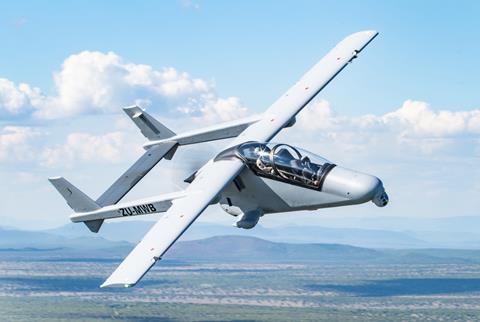
However, a legal dispute between the shareholders stopped all development operations in early 2019. Later that year Paramount, a global aerospace and technology company, took over as sole proprietor of the AHRLAC programme and relaunched its development.
Marketing efforts shifted to North America, where it was offered with Leidos as the Bronco II for the US Air Force’s (USAF’s) Armed Overwatch programme. One of five contenders, the Bronco II eventually lost out to the L3Harris/Air Tractor AT-802U for the Special Operations Command (SOCOM) requirement.

The rekindled programme has made notable progress since then, laying the groundwork for South African and US certification. Market acceptance was gained with the sale of a combined nine aircraft to neighbouring Mozambique and the Democratic Republic of Congo. Their first aircraft were delivered in late 2022 and the second half of last year, respectively, with production under way on the remaining examples.
Paramount touts the clean-sheet Mwari as an ideal low-cost aircraft for intelligence, surveillance and reconnaissance (ISR) and so-called F3EAD (find, fix, finish, exploit, analyse and disseminate) roles in austere environments.
FlightGlobal was invited to Paramount’s aircraft production and test facility at Wonderboom National airport near Pretoria late last year to experience first-hand the Mwari’s promising ability to fulfil these roles.
FIND, FIX, FINISH
The aircraft’s visual “find” capability is defined by its mission-driven layout. A high-wing and twin-boom pusher design places the two-seat, tandem cockpit out in space forward of the wing. The seats are arranged in a stadium manner, with the aft weapon system officer (WSO) sitting notably higher than the pilot.
A large bubble canopy affords a wide field of view (FOV) for both crew members, enabling the WSO to see directly forward over the pilot’s helmet. Additionally, there are no canopy bows or propeller arc for the pilot to contend with.

Onboard sensors highlight the Mwari’s “fix” function. Most prominent on the fuselage is the lower chin-mounted Hensoldt Argos-II electronic observation/infrared sensor (EOS). The 16in-class sensor ball offers a variety of high-definition daylight and infrared cameras, as well as laser rangefinder and illumination capabilities.
But while the Mwari may lead with its chin, an internal fuselage mission bay is its most versatile feature. The triangular bay can carry mission-specific “pods”, providing flexibility for operators. These pods, which can weigh up to 317kg (700lb), are plug and play, allowing mission reconfiguration in under 2h.
Additionally, the Mwari’s electrical system can supply 400kW of power: an essential feature for today’s electronics-intensive tactical arena.
To “finish” the job, the aircraft has six external hardpoints: three under each side of the wing. The four outboard stations can carry 280kg of ordnance each, while the two inboard stations can each carry up to 300kg, as external fuel tanks or weapons. A maximum load of 1,000kg can be carried across the NATO-standard 14in racks – not too bad for an aircraft that grosses out at only 4,500kg.
My preview of the Mwari consisted of three flights in a production representative aircraft, registration ZU-MWB. Factory test pilot Mark Berg was the demonstration pilot for each of the sorties, which were flown out of Paramount’s Wonderboom facility.
The first flight was in the rear (WSO) seat and served as an overall familiarisation flight, in preparation for front-seat sorties the following day. All flights were conducted in daylight, visual meteorological conditions. Being summer in the southern hemisphere, temperatures were in the high-20s to low-30s °C.
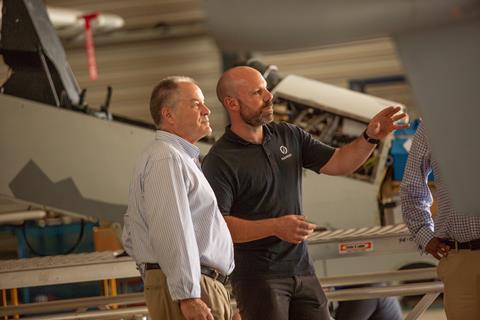
I followed Berg as he completed the pre-flight walkaround inspection, using the time to get acquainted with the Mwari’s features. Its high-wing and twin-boom arrangement reminded me of the Cessna O-2 (Cessna 337) I had flown as a forward air controller (FAC) in the USAF.
During my FAC assignment I flew over 500h in the “Duck”, gaining an appreciation for some of the roles that today’s Mwari was designed to fulfil. The much more capable Paramount design, with its robust trailing-link landing gear, has a stouter appearance than the old Cessna.
The Mwari’s primary structure is aluminium, with composites used for larger fairings. The forward-swept wing gives the aircraft a somewhat aggressive stance. Berg explained that the fuselage-wing join was placed aft of the rear cockpit to enhance the WSO’s FOV. The forward-sweep is not just for looks, but is needed to move the wing’s centre of pressure forward for longitudinal stability considerations.
RUGGED DESIGN
I noted that the underside of the wing was clean, with no external stores racks mounted. As we walked around the aft end of the fuselage and empennage, Berg emphasised that the pusher configuration was chosen to enhance operations from unprepared surfaces. This means that any foreign object debris kicked up by the large five-bladed Hartzell HC-E5N scimitar propeller will not damage the prominent chin-mounted EOS ball.
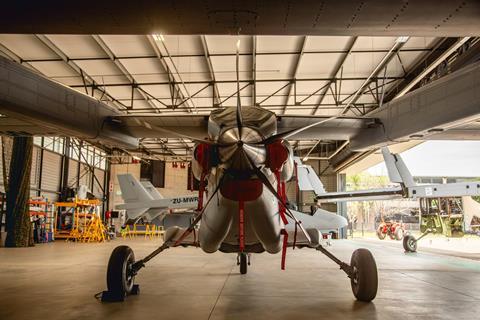
The entire inspection was straightforward and easily accomplished. Nearing the completion of the walkaround I asked if the aircraft is single-point refuelling capable: its fuel system has five internal wing tanks, which allows for gravity feed of the engine. Berg explained that each tank is over-wing fuelled by a simple hose – an essential feature for an aircraft optimised for austere operations.
We boarded the aircraft via the integral fuselage steps, and I settled into the rear seat. While the Mwari is provisioned for Martin-Baker Mk16 ejection seats, our aircraft was not fitted with them. Instead, the manual height-adjustable seats allow for the use of seat-pack parachutes, so I used the glare shield-mounted design eye point reference to set the proper height.
The rear station is fitted with a right-hand sidestick (SS), as well as rudder pedals, and a power lever is mounted on the left-hand console. But most importantly for the WSO, the mission element controller was also placed behind it, with the mission grip used to control the EOS.
Sensor output was presented on a massive 21in-diameter mission display, which dominates the rear station. The mission display is also used to control pod-installed mission systems. Additionally, there is a 6x8in centre-mounted multi-function display (MFD). This standalone screen has all the functionality of the front cockpit displays.

After completion of the pre-start checks, Berg closed the canopy, and using internal battery power alone started the Pratt & Whitney Canada PT6A-66B engine. He did the initial portion of the taxi, allowing me to take over once we were clear of the ramp. The elevated stadium seating gave a good view of the taxiway forward, and the long taxi to runway 29 gave me ample time to wrestle with the castoring nosewheel.
Holding short of the runway we confirmed take-off (TO) flaps of 20° and proper trim settings. Once aligned with the runway centreline and cleared for TO I slowly advanced the power lever to approximately 60% torque (TQ), releasing the wheel brakes after the engine had stabilised. 100% TQ was set as the Mwari accelerated to rotate at 76 knots indicated air speed (KIAS) (140km/h). Sidestick forces were moderate as I pulled aft to set a TO pitch attitude of 5-6°.
After lift-off Berg retracted the landing gear, with flap retraction started as we passed 200ft above ground level (AGL).
MANOEUVRING ALTITUDE
After turning out of the airport traffic area, a climb to 17,500ft mean sea level (MSL) was initiated. During the climb I did a series of heading changes to get a feel for the Mwari’s handling qualities. Levelling at our manoeuvring altitude I noted that our average rate of climb had been approximately 1,500ft/min.
Though I was in the back seat, Berg suggested I concentrate on familiarising myself with how the Mwari flies, in preparation for my front-seat evaluation flight, rather than operating the Argos-II system.
| Paramount Mwari specifications | |
|---|---|
| Dimensions | |
| Length | 10.85m |
| Height | 3.5m |
| Wingspan | 12.1m |
| Wing area | 20.7m2 |
| Weights | |
| Maximum take-off weight | 4,500kg |
| Maximum landing weight | 4,200kg |
| Basic empty weight* | 3,130kg |
| Internal pod capacity | 317kg |
| Maximum external weapons** | 1,000kg |
| External fuel tank capacity | 2 x 300kg |
| Engine | |
| Pratt & Whitney Canada PT6A-6B | x 1 |
| Maximum power | 950shp |
| Torque | 3,383Nm |
| Hartzell HC-E5N five-bladed propeller diameter | 2.13m |
| Performance | |
| Take-off distance*** | 610m |
| Operating ceiling | 24,000ft |
| Maximum airspeed (indicated) | 210kt (M0.38) |
| Load factor | +4.4 to -2.5g |
| Maximum ferry range**** | 2,000nm |
| Mission radius (500kg weapon load)**** | 520nm |
| Mission radius (1,000kg weapon load) | 180nm |
| Mission endurance***** | 6.5h |
| Landing distance*** | 610m |
| Source: Paramount Notes: *2 crew **Spread across six underwing pylons ***MTOW, SL, ISA ****With external tanks *****ISR role, 20,000ft | |
While level at 17,500ft two cruise performance points were conducted. Setting maximum TQ, 96.7% for an outside air temperature of 21°C (70°F), the Mwari settled at 179KIAS. Fuel flow was 493lb/h, with a resultant high-speed cruise true airspeed of 230kt.
After reducing TQ to 75% for a typical cruise condition, fuel flow decreased to 409lb/h. Our airspeed stabilised at 156KIAS (20kt faster than maximum-range cruise speed), with a resultant true airspeed of 212kt.
Satisfied that the Mwari could meet its range numbers, we next did some rolling manoeuvres up to 60° angle of bank, to assess control harmony and performance capability. Lateral stick forces for the mechanical SS were moderate, with perceived forces for right-hand rolls higher than the left. Actual stick forces were symmetrical, but typical arm strength is higher for pronation (left roll) than for supination (right roll).
STICK FORCES
Little rudder was needed to co-ordinate the rolls, and longitudinal stick forces were moderate as well. Carefree manoeuvring was further enhanced by available power sufficient to sustain 2.6g at 150KIAS.
The last event at altitude was an investigation of the Mwari’s Dutch Roll characteristics. Aft-swept wings, high-mounted wings and wings with dihedral are more susceptible to Dutch Roll, so I was curious to see how the Mwari – with its slight forward-sweep, high-mounted, no dihedral wing – would perform. At 155KIAS I did half-displacement rudder doublets, to excite the mode. I was not surprised when the resultant motion was snaky (more yawing than rolling) and well damped. The observed phi/beta (roll due to yaw) ratio was very low, with little roll response from rudder displacement.
With the medium-altitude manoeuvres complete, I initiated a descent to 10,000ft MSL, where we would evaluate the aircraft’s stall characteristics. During the descent we sampled the high-speed corner of the Mwari’s flight envelope. At 180KIAS we entered the amber region of the primary flight display airspeed tape. Ignoring the caution, I steepened the dive. We reached 192KIAS, where the red on the airspeed tape indicated that we had reached the Mwari’s never exceed speed.
While an aural “OVERSPEED” sounded I made a series of sharp control inputs in all three axes. The aircraft’s response was well damped in each axis.
Prior to slowing the aircraft for a stall evaluation, we performed some aileron rolls and wing-overs. Entry speed for these was 185KIAS, with 75% TQ set. During these manoeuvres I found roll response was slower than I would have liked, but more than adequate for the task.
As with the steep turns performed earlier, SS roll and pitch forces were well harmonised, with little rudder needed to co-ordinate.
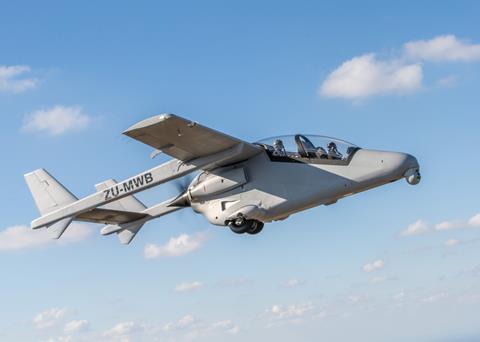
The aerobatics were an enjoyable way to slow the aircraft for a series of stalls. These were accomplished in both clean and landing (flaps 20° and gear down) configurations at idle power. A third accelerated stall was also performed in the clean configuration. Stall speeds for our weight were respectively 88 and 76KIAS.
In all cases an aural “STALL” was sounded, as was CAUTION, and WARNING messages well before the stall. Light airframe buffet was felt just prior to each event. The Mwari was rock steady at stall onset, with no tendency for a wing to drop. Holding full aft SS stabilised the aircraft in a wings-level, 1,500ft/min descent. During the descent the aircraft was responsive to small control inputs in all three axes. Recovery from the stalled flight conditions was affected by lowering the nose and adding power.
With the area manoeuvres complete, we descended to 6,000ft MSL for a return to Wonderboom. Two visual approaches were flown to runway 29: a touch and go; and a full stop. Pitch force changes during landing gear and flap extension were minor, with SS-mounted pitch trim readily zeroing out the changes.
Approach speed was 95KIAS for the flaps 20° configuration. Pitch attitude was fairly flat on final, offering a direct view of the runway and aim point from the rear seat. Power was retarded to IDLE at about 30ft AGL on each approach, with the flare manoeuvre started at about 10ft AGL.
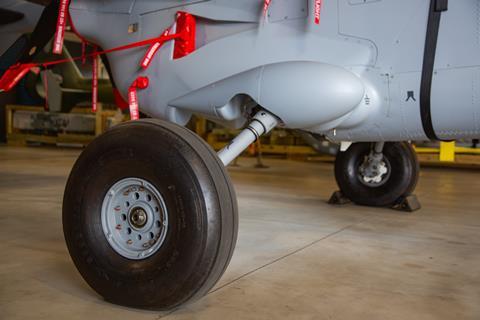
The Mwari’s robust trailing-link landing gear made for smooth touchdowns. On the full stop landing, wheel brakes were primarily used to slow the aircraft to taxi speed, with some assist from the engine with its propeller in beta range. Taxi back to Paramount’s ramp after completion of the sortie was uneventful.
MISSION FOCUS
With the back-seat familiarisation under my belt, my first front-seat sortie in the Mwari was launched the following day. This flight was more mission-oriented in nature, to better reflect how the aircraft will be employed.
After strapping into the front seat, I closed the large canopy and marvelled at the extensive FOV the Mwari has. Checks were completed by reference to a paper checklist prior to Berg guiding me through the engine start procedure. After start checks were completed and flaps set to 20°, I released the brakes for our taxi to runway 29.
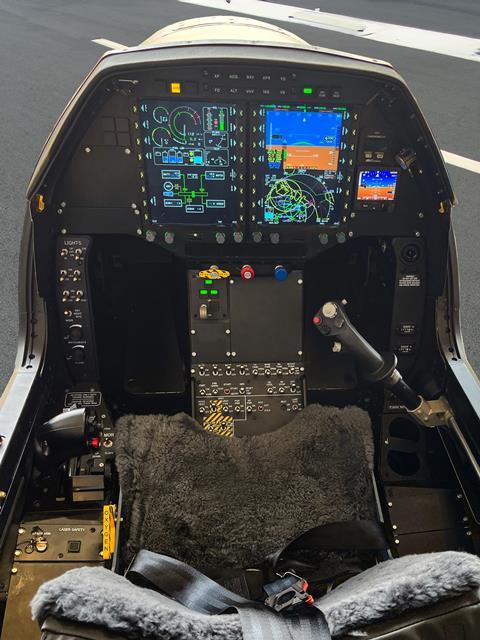
Taxiing seemed easier from the front seat, no doubt helped by my practice the previous day. The take-off was uneventful, with the Mwari smoothly lifting off the runway after a ground run of about 650m (2,130ft). With gear and flaps retracted we climbed to 7,000ft MSL for transit away from the airport traffic area to the north. With 34% TQ set the Mwari held 127KIAS. True airspeed was 140kt, with a fuel flow of only 345lb/h.
Once clear of populated areas we descended to 500ft AGL for low-level ingress to locate a simulated tactical target: the “find” part of F3EAD. While the flight management system (FMS) can calculate arrival times at tactical points for any airspeed, I like to keep things simple. Ever since flying General Dynamics F-111s out of RAF Upper Heyford in the UK I have planned low levels at speeds as a multiple of 60kt true, to ease the miles per minute mental gymkhana for time over target control.
At 180kt true airspeed (three miles per minute) the Mwari had a fuel flow of 480lb/h for International Standard Atmosphere +21°C conditions. Pitch control was precise, with targeted altitude easy to maintain.
Nearing the search area, I started a gradual climb to give Berg, who was filling the WSO/sensor operator role, a better vantage to find our target. I called up the Argos-II display on my MFD and watched as Berg located our target, a small outbuilding.
Through the FMS’s search and rescue page I set up a 2nm (3.7km)-radius orbit around the target. While the Mwari is slated to have an autopilot, in its current state of development I needed to hand-fly the manoeuvre.
TARGET LOCATION
The Mwari’s rear station has a keyboard, allowing the WSO to record observations about the target. In the O-2, with a higher phi/beta ratio than the Mwari, I would have used my feet to bank the aircraft: freeing my hands to write on the plexiglass window with a chinagraph marker! During the orbit Berg used the EOS with its laser rangefinder to “fix” the target’s location.
Orbiting a single point in a tactical environment is not without risk. The Mwari, however, is provisioned for survivability, from electronic warfare warning and countermeasures systems including chaff and flare dispensers. Ballistic protection panels and optional ejection seats also enhance crew survivability.
With its six hardpoints, the Mwari can carry a large amount of ordnance. A variety of smart weapons can be employed, allowing for precise targeting and reduced collateral damage.
The Mwari’s current state of development does not yet include visual aiming capability. The canopy affords a large FOV, but the small clearance between it and the front cockpit glareshield limit the potential to fit an optical sight or head-up display.
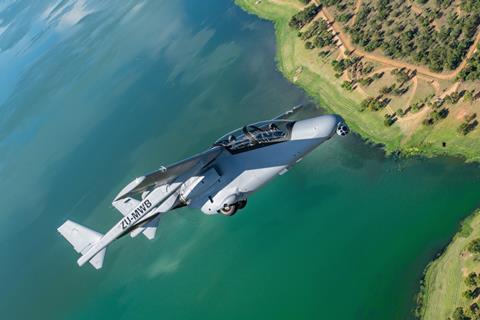
“Dumb” weapons can be released by reference to heads-down guidance cues, a practice not without risk in threat areas.
Since it is touted as a low-cost warrior, work is under way to allow the Mwari to employ unguided rockets or external gun pods. As part of the Armed Overwatch competition for SOCOM, smart weapons were integrated and successfully tested on the Bronco II. Now United Arab Emirates-headquartered, Paramount is currently working on the integration of smart weapons, allowing employment from safer heights and distances from threats.
FORCED LANDING
During our initial return leg, Berg hinted that our ultra-reliable PT6A engine was showing signs of “giving out”. As luck would have it, we were just to the south of Freeway – a dirt/gravel strip 11nm north of Wonderboom. I started a climb and turned towards a downwind for runway 20, to set up for a practice forced landing. Abeam the midfield point of the 2,900m-long runway we were well above the recommended “Low Key” altitude of 1,500ft AGL/5,300ft MSL.
Berg set a zero-thrust TQ of 3% for the simulated engine failure. I extended the landing gear and flaps early in an effort to get down. On final with landing assured, flaps 30 were selected.
With such a long runway I was able to concentrate on a smooth touchdown, not just on getting the aircraft down in the first third. On the runway I used light wheel braking to slow the Mwari for the 180° turn and taxi back. Take-off from the unpaved strip was the same as from a paved one, except for a slower application of power to reduce kicked-up debris.
Our return to Wonderboom was at 6,000ft MSL for the RNAV approach to runway 29, in visual conditions. I followed Berg’s actions as he loaded the approach into the FMS. Once activated, I flew the RNAV ground track by reference to the MFD’s map display. The aircraft was configured for landing at flap 20°.
The responsive PT6A made airspeed control on final a breeze, with little effort needed to hold the 90KIAS approach speed. After Berg called “Minimums”, I transitioned to visual references for a touch and go.
We next completed a visual circuit to runway 29. The full stop approach and landing was in a no flap configuration, with approach speed now 114KIAS. Pitch attitude on final was higher than the previous flap 20° approaches. With the lower drag configuration, I retarded power to IDLE at 50ft AGL so we would not float past the normal touchdown point.
Once on the runway, moderate wheel braking along with reverse thrust (beta range propeller) were used to slow the Mwari for runway turn-off. My increasing confidence with the castoring nose wheel made for a quick taxi back to the ramp.
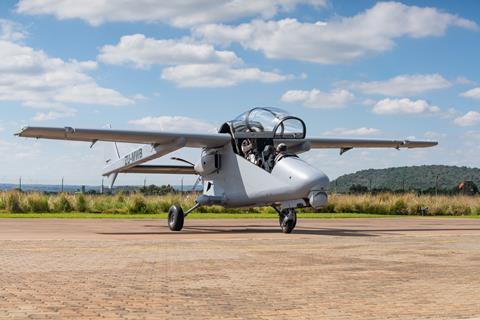
In all my preview flights made for FlightGlobal over the years, I can count on one hand the number of aerial photo shoots, but my final Mwari flight was such a sortie. For nearly an hour I had the pleasure of flying formation with a Cessna Caravan. Flying the close-up shots was akin to performing a close route formation in the Lockheed Martin F-16 – a skill I was pleased to reacquaint myself with over the countryside northwest of Pretoria.
The dynamic shots required aggressive manoeuvering in the vertical to expeditiously reposition for the next shot. The Mwari’s response to stick inputs allowed for precise station keeping, while the responsive PT6A enabled rapid speed control. During the vertical reposition manoeuvres, however, I would have liked faster roll rates.
After a smooth landing at Wonderboom and taxi to the ramp, I dropped my mask to reveal a big smile. The Mwari was a joy to fly in formation, displaying responsive and predictable handling qualities.

My past Airborne FAC tour in the USAF on the O-2 gave me an appreciation for the missions the Mwari is designed to fulfil. Additionally, I have previously had the good fortune to fly other light tactical aircraft, including the Beechcraft T-6 Texan II and Embraer EMB-314 Super Tucano.
While the turboprop light tactical aircraft space is well stocked with established and other new offerings, the Mwari is a welcome addition, with its internal pod system and pending smart weapons integration enabling it to make its presence felt over the battlefield.
Designed and built in South Africa, it promises to be a rugged and highly capable multi-role tactical aircraft with a promising home field advantage.



















